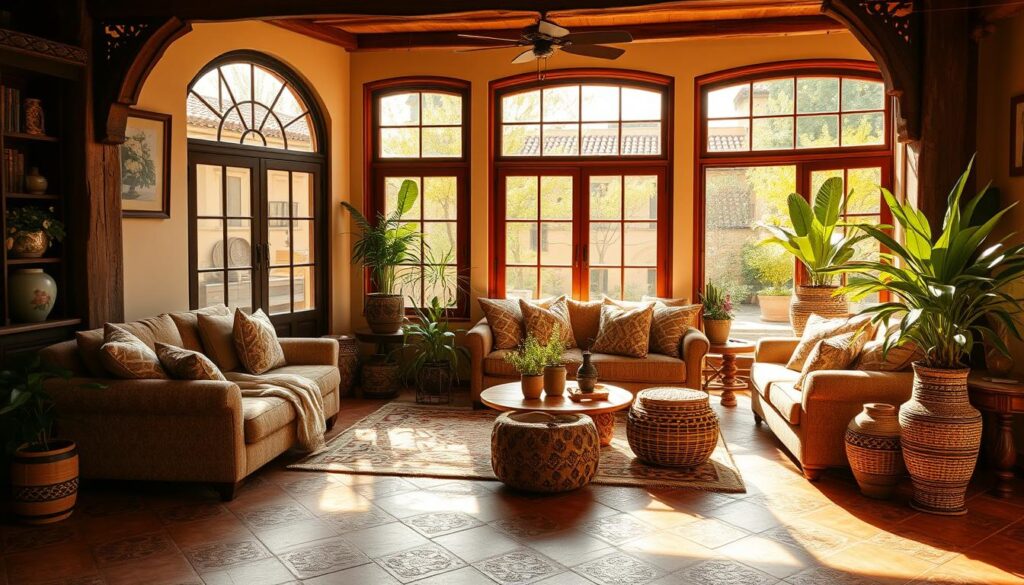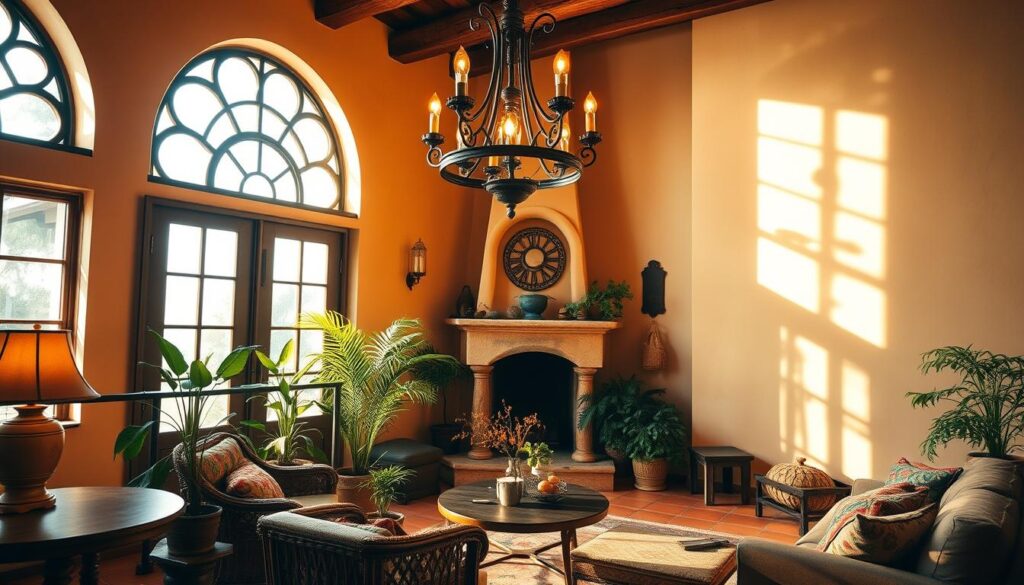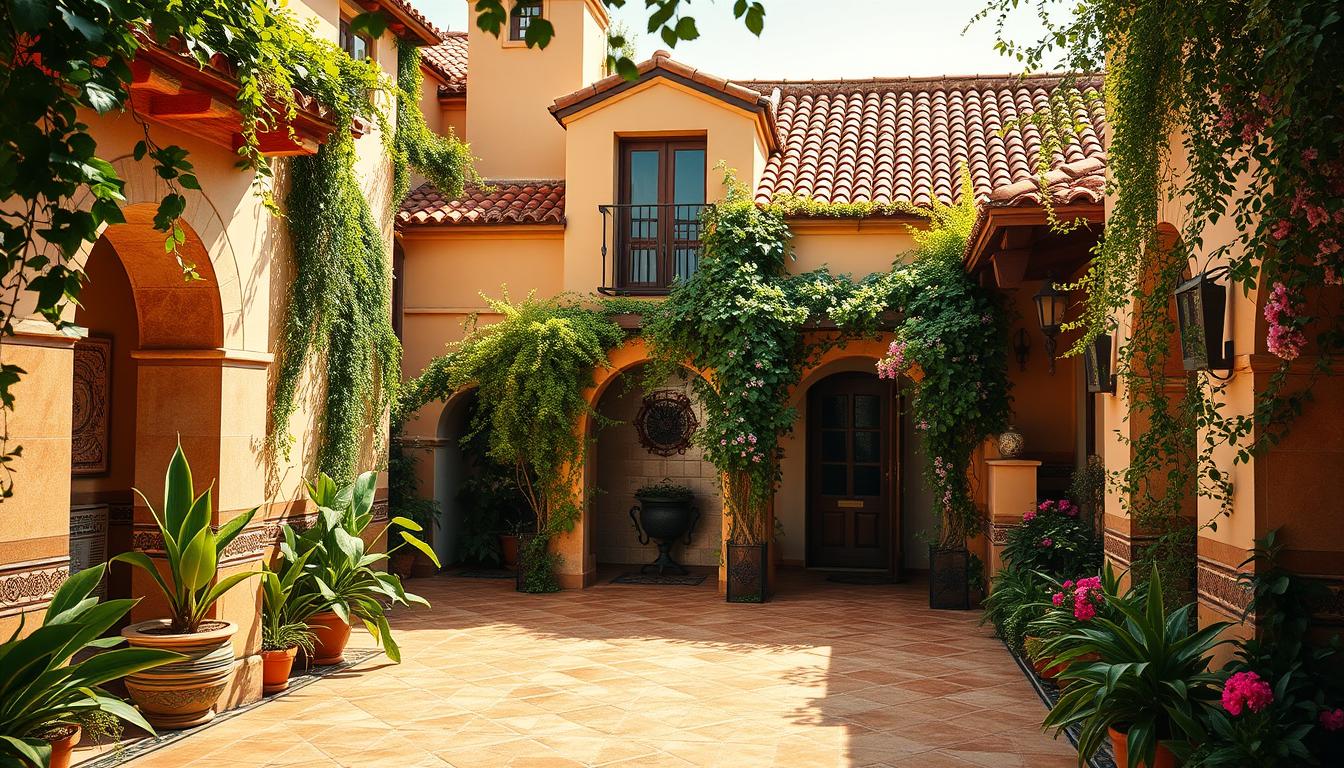Did you know the charm of Mediterranean design comes from mixing the sun’s warmth with earthy tones? It turns homes into peaceful havens.
The Mediterranean style decor is more than looks. It’s about making a home feel both snug and refined. It uses natural materials, arches, and columns to add history and warmth.
Exploring Mediterranean designs shows us how they make our homes more welcoming and stylish.
Key Takeaways
- Understanding the essence of Mediterranean style decor
- How natural materials enhance the aesthetic
- The role of arches and columns in design
- Creating a cozy yet sophisticated lifestyle
- Bringing history and warmth into your living space
Introduction to Mediterranean Home Interiors
Mediterranean home interiors are warm and elegant. They draw inspiration from the sun-kissed landscapes and rich culture of the Mediterranean. This style is popular for blending traditional and modern elements, making homes inviting.
What Defines Mediterranean Style?
The Mediterranean style uses natural materials like stone, wood, and clay. These materials are often left natural to keep their beauty. The color palette features earthy tones and vibrant sea and sky colors.
Decorative elements like tile work, wrought iron, and hand-painted ceramics add depth. They make Mediterranean interiors visually interesting.
Key Characteristics of Mediterranean Design
Mediterranean design is known for arched doorways and windows. These add elegance and connect indoors to outdoors. Tile roofing is also a key feature, offering durability and a unique look.
The use of natural stone and stucco finishes adds warmth. These finishes create the earthy ambiance of Mediterranean homes.
The Mediterranean color palette is key to these homes’ aesthetic. Warm earth tones like terracotta and sienna are balanced by cool sea and sky colors. This contrast is visually appealing and calming.
Popular Color Palettes
The Mediterranean color palette captures the essence of this timeless design style. It reflects the region’s natural beauty, from the sun-kissed earth to the deep sea.
Mediterranean interior design is known for its color use. The palette is inspired by nature, blending indoors with outdoors seamlessly.
Warm Earth Tones
Warm earth tones are key in the Mediterranean color palette. These include terracotta, beige, and golden hues that remind us of the Mediterranean landscape. Terracotta, in particular, adds warmth and coziness to spaces.
These earthy tones are pleasing to the eye and make spaces feel comfortable and relaxing. They can be used on walls, floors, and furniture for a cohesive look.
Vibrant Blues and Greens
Vibrant blues and greens are also part of Mediterranean color schemes. These colors are inspired by the sea and sky, adding a refreshing touch to interiors.
Blue brings calmness and serenity to Mediterranean design. It pairs well with white or earthy tones for a beautiful contrast. Green, reminiscent of the region’s lush vegetation, adds a natural element.
Together, these colors create a unique and captivating Mediterranean color palette. It’s a great interior design inspiration for those wanting to bring the Mediterranean into their homes.
Traditional Mediterranean Architecture
Mediterranean architecture comes from ancient times. It’s known for arched doorways and tile roofs. These features make homes look beautiful and tell the story of the region’s culture and history.
Arched Doorways and Windows
Arched doorways and windows are key in Mediterranean homes. They bring elegance and a sense of grandeur. They also help blend indoor and outdoor spaces, a key part of Mediterranean design.
Arched doorways and windows offer many benefits:
- They let in more natural light.
- They improve air flow.
- They look great.
Architects say arches are not just pretty. They also help with weight distribution and allow for bigger openings. For centuries, arches have been a key part of Mediterranean homes, combining beauty with function.
Tile Roofing Styles
Tile roofs are a big part of Mediterranean architecture. The area uses clay tiles, which are strong and add to the homes’ unique look. These tiles come in different shapes and colors, making each home special.
Some common tile roofing styles include:
- Barrel tiles, known for their curved shape
- Flat tiles, often used with barrel tiles
- Decorative tiles, adding extra visual interest
“The choice of roofing material and style is crucial in defining a Mediterranean home’s character. Clay tiles, in particular, are loved for their beauty and lasting quality.”
The mix of arched doorways, windows, and tile roofs makes Mediterranean architecture unique and appealing.
Key Materials Used in Mediterranean Interiors
Natural materials are key in Mediterranean interior design. They bring warmth and authenticity. These materials make a space look good, last long, and feel comfortable.
Natural Stone and Stucco
Natural stone and stucco are essential in Mediterranean design. They add texture and history to a room.
Natural stone, like limestone and travertine, is used for floors, walls, and decor. Stucco, made from cement, water, and lime, gives walls a smooth, lasting finish.
| Material | Characteristics | Common Uses |
|---|---|---|
| Natural Stone | Durable, unique patterns | Flooring, walls, decorative features |
| Stucco | Versatile, durable finish | Walls, exterior finishes |
Wrought Iron Accents
Wrought iron is popular in Mediterranean interiors. It’s strong, versatile, and looks great.
Wrought iron is seen in furniture, lights, and decor like railings and grilles. It adds elegance and connects indoors to outdoors.
Furniture Choices for Mediterranean Homes
Furniture is key in Mediterranean homes, blending rustic and plush styles. The right pieces can make you feel like you’re on the Mediterranean coast. They bring warmth and a sense of welcome.
Rustic Wooden Pieces
Rustic wooden furniture is a must in Mediterranean homes. It adds warmth and authenticity. Wooden pieces with a distressed finish are loved for their history and charm.
Wooden tables, chairs, and cabinets are not just useful. They also decorate the space, adding to the Mediterranean aesthetic.
Looking for rustic wooden furniture? Check out local antique shops or artisan workshops. You can also find great tips online, like Mannington’s guide to Mediterranean design.
Plush, Comfortable Upholstery
Plush, comfortable upholstery is also essential in Mediterranean furniture. Sofas and armchairs in rich, vibrant fabrics add color and comfort. Velvet and linen are top picks for their soft, luxurious feel and durability.
When picking upholstery, think about the colors and look you want. Mediterranean design often uses earthy and rich jewel tones. Mixing these with rustic wood creates a stylish, cozy space.
Decorating with Texture
Texture is key in Mediterranean decor, making spaces cozy and welcoming. Mixing different textures adds depth and interest. This makes a room feel more inviting and real.
One great way to do this is by layering fabrics. Using linen, cotton, and velvet together creates a rich look. For example, a linen sofa with velvet pillows and a cotton throw makes a room pop. For more Mediterranean design ideas, check out Architectural Digest.
Layering Fabrics
Layering fabrics is an art that needs careful thought. Start with a base, like a linen sofa or cotton rug. Then, add layers with different textures. For example, a velvet throw or woven basket adds depth.
Some top fabrics for layering are:
- Linen
- Cotton
- Velvet
- Wool
Incorporating Natural Elements
Adding natural elements also brings texture to a space. Elements like woven baskets, plants, and natural stone warm and texture a room.

| Natural Element | Benefits |
|---|---|
| Woven Baskets | Adds texture and storage |
| Plants | Brings in a natural touch and purifies the air |
| Natural Stone | Adds warmth and visual interest |
Using these elements makes a space visually appealing and textured. For help with your Mediterranean home design, visit EPJ CodeT.
Outdoor Living Spaces
In Mediterranean homes, outdoor areas are key, not just extras. They blend indoors and outdoors smoothly. This makes living better.
Outdoor spaces in these homes feel warm and welcoming. Al fresco dining areas are a big hit. They let people enjoy meals outside, surrounded by nature.
Al Fresco Dining Areas
Al fresco dining is a big part of Mediterranean outdoor living. These areas are made for comfort and style. They use strong furniture and decor that shows off the Mediterranean look.
To make an al fresco dining area inviting, use natural materials like stone or wood. Adding things like lanterns or woven textiles can also make it feel cozier.
Courtyards and Gardens
Courtyards and gardens are also important in Mediterranean homes. They offer a calm break from everyday life. They’re peaceful spots to relax and chill out.
When setting up a courtyard or garden, think about using plants from the Mediterranean, like olive trees or lavender. Using natural stone or brick for paths and walls can also make the space feel more real.
To show what makes Mediterranean outdoor living spaces great, here’s a table:
| Feature | Description | Benefits |
|---|---|---|
| Al Fresco Dining | Outdoor dining areas designed for comfort and functionality | Enhances dining experience, encourages outdoor living |
| Courtyards and Gardens | Tranquil retreats featuring native Mediterranean plants | Provides peace and relaxation, connects with nature |
| Natural Materials | Incorporation of stone, wood, and other natural elements | Adds authenticity, enhances aesthetic appeal |
By adding these features, homeowners can make outdoor spaces that are not just pretty but also useful and welcoming. These spaces truly capture the spirit of Mediterranean home design.
Lighting in Mediterranean Interiors
Lighting in Mediterranean interiors is all about finding the right mix. We need to use natural light and decorative lights to add warmth and character. This mix is key to creating the inviting feel of Mediterranean homes.
Good lighting can make a space feel bigger and more welcoming. It’s all about creating a warm and inviting atmosphere.
Emphasizing Natural Light
Natural light is essential in Mediterranean design. It brings out the rich textures and colors of this style. Features like large windows and skylights help to let in more light.
By focusing on natural light, we connect indoors with outdoors. This makes the home look better and feel more open.
Maximizing natural light also means we use less artificial light. It highlights the beauty of the home’s design and decor. It’s a simple way to make a space feel warm and welcoming.

Decorative Light Fixtures
Decorative lights are also important in Mediterranean interiors. Wrought iron chandeliers, pendant lights, and sconces are popular. They often have intricate designs that show off Mediterranean craftsmanship.
These lights do more than just light up a room. They become part of the room’s look, adding to its charm. Choosing the right lights can make our homes feel warmer and more inviting.
| Fixture Type | Characteristics | Benefits |
|---|---|---|
| Wrought Iron Chandeliers | Intricate designs, durable | Adds elegance, durable |
| Pendant Lights | Versatile, stylish | Provides focused lighting, adds style |
| Sconces | Wall-mounted, ambient lighting | Creates ambiance, saves space |
By mixing natural light with decorative lights, we can make a Mediterranean interior that’s both beautiful and functional. This approach to lighting is key to achieving the warm, inviting feel of Mediterranean style decor.
Incorporating Art and Accessories
In Mediterranean homes, art and accessories add personality and cultural depth. They reflect the region’s rich heritage and make the space unique.
Choosing the right art and accessories is key for a Mediterranean-inspired home. Hand-painted ceramics are a must, adding color and craftsmanship.
Hand-Painted Ceramics
Hand-painted ceramics, like vases and plates, are both functional and decorative. They show the Mediterranean’s artisanal traditions. Their vibrant colors and designs add interest to any room.
- Use hand-painted ceramics as centerpieces or decorative accents on shelves and mantels.
- Group ceramics together to create a visually appealing display.
- Incorporate ceramics into your kitchen or dining area to add a touch of Mediterranean charm.
Tapestries and Wall Hangings
Tapestries and wall hangings bring art and culture into your home. They add texture, color, and pattern, making your space cozy and inviting.
Interior design experts say, “Tapestries and wall hangings can transform a room by adding a layer of depth and visual interest.”
“The use of tapestries and wall hangings in Mediterranean interiors not only reflects the region’s rich textile heritage but also adds a unique touch to the decor.”
Choose tapestries and wall hangings that match the Mediterranean style. Look for natural motifs, geometric patterns, or scenes inspired by the region’s history and culture.
By adding art and accessories like hand-painted ceramics, tapestries, and wall hangings, you can make your home beautiful and culturally rich.
Designing a Cozy Living Room
Mediterranean design brings warmth and beauty to our homes. A cozy living room is a perfect example. We’ll see how to make a space that feels like a Mediterranean home.
Fireplaces as Focal Points
A fireplace is key in a cozy living room. In Mediterranean homes, it’s more than just heat. It’s a design statement. We can add Mediterranean furniture around it for a cozy spot.
Imagine a rustic stone fireplace with plush, earth-toned sofas. Add wrought iron or colorful ceramics for a Mediterranean touch.
Layout Tips for Family Gatherings
Our goal is a space for family to gather and talk. Arrange furniture to encourage this, like a circle around the fireplace. Or a coffee table in the middle.
- Use a mix of sofas, armchairs, and ottomans for flexibility.
- Choose a sturdy coffee table from natural wood or stone.
- Include a cozy reading nook with a plush chair and a floor lamp.
To truly capture Mediterranean design, add elements that show the region’s culture. Think hand-painted ceramics, woven textiles, and natural stone or brick.
“The beauty of Mediterranean design lies in its ability to blend the old with the new, creating a warm and inviting atmosphere that feels both timeless and contemporary.”
| Element | Description |
|---|---|
| Fireplace | Rustic stone or ornate tile surround |
| Seating | Plush sofas and armchairs in earth tones |
| Coffee Table | Natural wood or stone |
| Decor | Wrought iron accents, colorful ceramics |
With these elements and tips, we can make a cozy living room. It will reflect Mediterranean design’s warmth and beauty. And it will be a welcoming space for family and friends.
Bringing Mediterranean Charm into Modern Homes
Mediterranean home designs mix old and new in a special way. To add Mediterranean charm to modern homes, finding a balance is key.
Blending Traditional and Contemporary Elements
Adding traditional touches like arched doorways and tile roofs to modern homes is exciting. Mixing these with modern materials and finishes makes rooms flow well together.
Creating a Seamless Flow
It’s important to make rooms feel connected for a true Mediterranean feel. Use the same colors, natural textures, and furniture that fits the home’s style.
Following these design tips, homeowners can make their modern homes feel warm and welcoming. It’s a way to bring the beauty of the Mediterranean into their homes.


